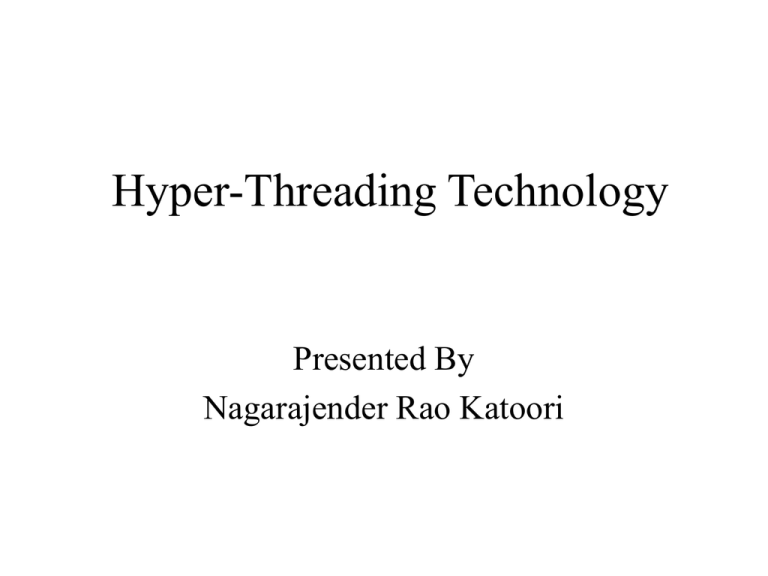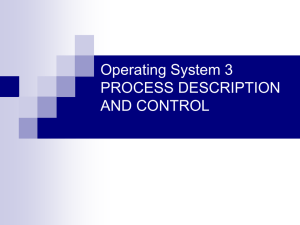ppt
advertisement

Hyper-Threading Technology Presented By Nagarajender Rao Katoori Introduction To Enhance Performance- Increase in clock rate o Involves reducing clock cycle time o Can increase the performance by increasing instructions finishing per second number of o H/w limitations limit this feature Cache hierarchies o Having frequently used data on the processor caches reduces average accesses time Pipelining o Implementation Technique whereby multiple instructions are overlapped in execution o Limited by the dependencies between instructions o Effected by stalls and effective CPI is greater than 1 Instruction Level Parallelism o It refers to techniques to increase the number of instructions executed in each clock cycle. o Exists whenever the machine instructions that make up a program are insensitive to the order in which they are executed if dependencies does not exist, they may be executed. Thread level parallelism Chip Multi Processing o Two processors, each with full set of execution and architectural resources, reside on a single die. Time Slice Multi Threading o single processor to execute multiple threads by switching between them Switch on Event Multi Threading o switch threads on long latency events such as cache misses Thread level parallelism (cont..) Simultaneous Multi Threading o Multiple threads can execute on a single processor without switching. oThe threads execute simultaneously and make much better use of the resources. oIt maximizes the performance vs. transistor count and power consumption. Hyper-Threading Technology Hyper-Threading Technology brings the simultaneous multithreading approach to the Intel architecture. Hyper-Threading Technology makes a single physical processor appear as two or more logical processors Hyper-Threading Technology first invented by Intel Corp. Hyper-Threading Technology provides thread-levelparallelism (TLP) on each processor resulting in increased utilization of processor and execution resources. Each logical processor maintain one copy of the architecture state Hyper-Threading Technology Architecture Arch State Arch State Arch State Processor Execution Resources Processor Execution Resources Processor with out HyperThreading Technology Processor with HyperThreading Technology Ref: Intel Technology Journal, Volume 06 Issue 01, February 14, 2002 Following resources are duplicated to support HyperThreading Technology Register Alias Tables Next-Instruction Pointer Instruction Streaming Buffers and Trace Cache Fill Buffers Instruction Translation Look-aside Buffer Figure: Intel Xeon processor pipeline Sharing of Resources Major Sharing Schemes areo Partition o Threshold o Full Sharing Partition Each logical processor uses half the resources Simple and low in complexity Ensures fairness and progress Good for major pipeline queues Partitioned Queue Example • Yellow thread – It is faster thread • Green thread – It is slower thread Partitioned Queue Example • Partitioning resource ensures fairness and ensures progress for both logical processors. Threshold Puts a threshold on number of resource entries a logical processor can use. Limits maximum resource usage For small structures where resource utilization in burst and time of utilization is short, uniform and predictable Eg- Processor Scheduler Full Sharing Most flexible mechanism for resource sharing, do not limit the maximum uses for resource usage for a logical processor Good for large structures in which working set sizes are variable and there is no fear of starvation Eg: All Processor caches are shared o Some applications benefit from a shared cache because they share code and data, minimizing redundant data in the caches Netburst Microarchitecture’s execution pipeline SINGLE-TASK AND MULTI-TASK MODES • Two modes of operations – single-task (ST) – multi-task (MT). • MT-mode- There are two active logical processors and some of the resources are partitioned. • There are two flavors of ST-mode: single-task logical processor 0 (ST0) and single-task logical processor 1 (ST1). • In ST0- or ST1-mode, only one logical processor is active, and resources that were partitioned in MT-mode are recombined to give the single active logical processor use of all of the resources SINGLE-TASK AND MULTI-TASK MODES • HALT instruction that stops processor execution. • On a processor with Hyper-Threading Technology, executing HALT transition the processor from MT-mode to ST0- or ST1-mode, depending on which logical processor executed the HALT. • In ST0- or ST1-modes, an interrupt sent to the halted logical processor would cause a transition to MT-mode. OPERATING SYSTEM • For best performance, the operating system should implement two optimizations. – The first is to use the HALT instruction if one logical processor is active and the other is not. HALT will allow the processor to transition MT mode to either the ST0- or ST1-mode. – The second optimization is in scheduling software threads to logical processors. The operating system should schedule threads to logical processors on different physical processors before scheduling two threads to the same physical processor. Business Benefits of Hyper-Threading Technology • Higher transaction rates for e-Businesses • Improved reaction and response times for end-users and customers. • Increased number of users that a server system can support • Handle increased server workloads • Compatibility with existing server applications and operating systems Performance increases from Hyper-Threading Technology on an OLTP workload Web server benchmark performance Conclusion •Intel’s Hyper-Threading Technology brings the concept of simultaneous multi-threading to the Intel Architecture. •It will become increasingly important going forward as it adds a new technique for obtaining additional performance for lower transistor and power costs. •The goal was to implement the technology at minimum cost while ensuring forward progress on logical processors, even if the other is stalled, and to deliver full performance even when there is only one active logical processor. References • “HYPER-THREADING TECHNOLOGY ARCHITECTURE AND MICROARCHITECTURE” by Deborah T. Marr, Frank Binns, David L. Hill, Glenn Hinton,David A. Koufaty, J. Alan Miller, Michael Upton, intel Technology Journal, Volume 06 Issue 01, Published February 14, 2002. Pages: 4 –15. • “:HYPERTHREADING TECHNOLOGY IN THE NETBURST MICROARCHITECTURE” by David Koufaty,Deborah T. Marr, IEEE Micro, Vol. 23, Issue 2, March–April 2003. Pages: 56 – 65. • http://cachewww.intel.com/cd/00/00/22/09/220943_220943.pdf • http://www.cs.washington.edu/research/smt/papers/tlp2ilp.fin al.pdf • http://mos.stanford.edu/papers/mj_thesis.pdf Thank you





